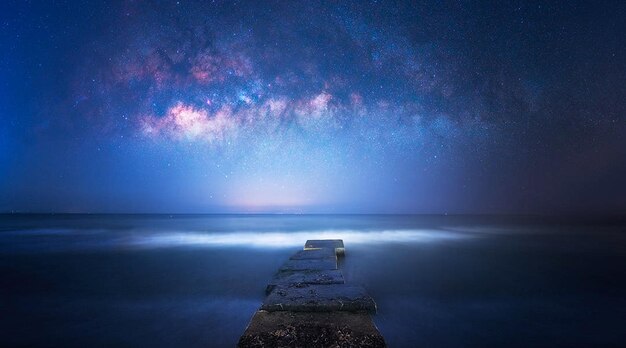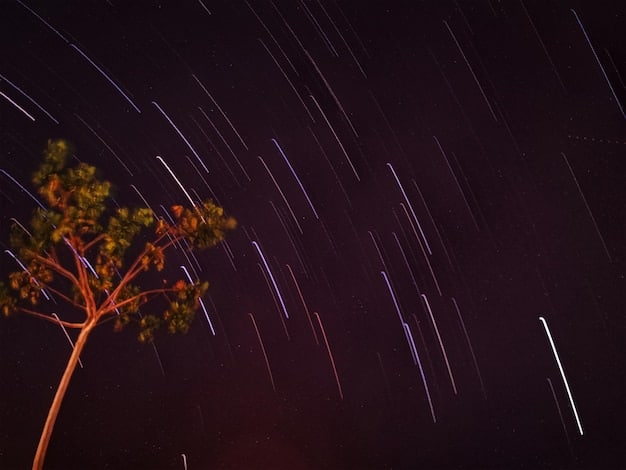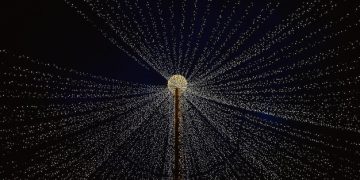2025’s Must-See Celestial Events: An Astrological Guide

2025’s rare celestial events offer unparalleled opportunities for stargazers, featuring a spectacular lineup of eclipses, meteor showers, and planetary alignments that promise breathtaking views and unique astronomical moments, making it a year to remember for enthusiasts in the United States.
Get ready, stargazers! 2025’s rare celestial events are shaping up to be an incredible year for astronomical wonders. From mesmerizing eclipses to dazzling meteor showers, the cosmos is putting on a show you won’t want to miss. Prepare your telescopes and mark your calendars for these unmissable astrological opportunities!
Celestial Spectacles Awaiting in 2025
2025 promises to be a remarkable year for astronomy enthusiasts, with a series of celestial events that will captivate observers of all levels. These events offer a chance to witness the beauty and grandeur of the universe from the comfort of our own planet.
Let’s dive into some of the most anticipated celestial happenings on the horizon, ensuring you’re well-prepared to make the most of these astronomical opportunities.
Total Lunar Eclipse in March
One of the first major events of the year is the total lunar eclipse in March. During this eclipse, the Earth will pass directly between the Sun and the Moon, casting a shadow that turns the Moon a deep red hue.
This “blood moon” effect is a result of sunlight filtering through the Earth’s atmosphere and refracting onto the lunar surface, which creates an unforgettable sight.
Annular Solar Eclipse in September
In September, skywatchers will be treated to an annular solar eclipse. This occurs when the Moon passes between the Sun and the Earth, but the Moon is too far away to completely cover the Sun.
As a result, a brilliant ring of sunlight, known as the “ring of fire,” will be visible around the Moon, creating a stunning visual effect.
- Prepare Eye Protection: Always use certified solar viewing glasses or filters when directly observing a solar eclipse to protect your eyes.
- Find a Clear Location: Choose a viewing location with an unobstructed view of the sky, away from city lights or tall buildings.
- Check the Weather: Keep an eye on weather forecasts to ensure clear skies on the day of the eclipse.
The total lunar eclipse in March and the annular solar eclipse in September are just the beginning of what 2025 has in store for skywatchers. These events provide perfect opportunities to connect with the cosmos and appreciate the beauty of our universe.
The Lyrid Meteor Shower in April
April brings the annual Lyrid meteor shower, a celestial display known for its fast and bright meteors. This shower is created by debris from Comet Thatcher, which was first observed in 1861.
Under clear skies, the Lyrid meteor shower can produce up to 20 meteors per hour during its peak, offering a spectacular show for those willing to stay up late or wake up early.
Peak Viewing Times
The best time to view the Lyrid meteor shower is typically in the early morning hours, after midnight, when the radiant point of the shower, located in the constellation Lyra, is high in the sky.
Find a dark location away from city lights to maximize your chances of seeing the fainter meteors.
Tips for Observing Meteor Showers
Viewing meteor showers requires patience and the right conditions. To make the most of your meteor-watching experience, consider the following tips.
These showers, like the Lyrid are a true spectacle to behold, and with some planning you’ll be able to enjoy them thoroughly.
- Acclimatize Your Eyes: Allow your eyes to adjust to the darkness for at least 20-30 minutes to improve your night vision.
- Bring a Blanket or Chair: Staying comfortable is important for those long hours of stargazing.
- Avoid Using Your Phone: The bright light from your phone can disrupt your night vision.
The Lyrid meteor shower is just one of many opportunities throughout the year to witness the beauty of meteor showers. Each shower has its unique characteristics and peak times, making every event a special occasion. Make sure to check them all out!

Planetary Alignments: A Visual Treat
Planetary alignments are among the most visually stunning celestial events. These alignments occur when multiple planets appear to line up in the sky from our perspective on Earth.
While the planets are not actually aligned in space, their apparent proximity creates a beautiful and striking visual effect.
The Grand Alignment of June
In June 2025, stargazers will be treated to a grand planetary alignment featuring several of the solar system’s brightest planets. Planets such as Venus, Mars, Jupiter, and Saturn will appear close together in the morning sky.
This alignment will be visible to the naked eye, offering a fantastic opportunity to witness the grandeur of our solar system.
How to Observe Planetary Alignments
Observing planetary alignments requires a bit of planning, but the results are well worth the effort. Here’s how you can make the most of these celestial events.
The most important thing to remember is that these are truly rare events, so make sure not to miss them!
- Check Visibility: Use astronomy apps or websites to determine the best viewing times and locations for the planetary alignment.
- Find a Clear Horizon: Look for a location with a clear view of the horizon in the direction of the alignment.
- Use Binoculars or a Telescope: Enhance your viewing experience with binoculars or a telescope to see the planets in greater detail.
Planetary alignments are visual treats that remind us of the vastness and beauty of our solar system. Each alignment is unique, with different planets coming together in various configurations, making every event a special experience for stargazers.
Observing the Conjunction of Venus and Jupiter
A conjunction occurs when two or more celestial objects appear close together in the sky. Observing the conjunction of Venus and Jupiter can be a breathtaking sight. These are the two brightest planets in our sky, and when they come close, they create a dazzling spectacle.
Planning ahead of time is key to observing this phenomenon, so let’s take a look at how to plan appropriately.
Best Times for Observation
Throughout 2025, there will be several opportunities to observe the conjunction of Venus and Jupiter. However, the most prominent conjunction is expected to occur in late July. At this time, these two planets will be closest to each other.
- Early Risers Benefit: The best time to observe this conjunction is in the early morning hours, just before sunrise.
- Clear Skies: Check the weather forecast to ensure a clear sky for optimal viewing.
- Binoculars Enhance Viewing: Using binoculars will help you get a clearer view of the planets, especially in areas with light pollution.
The conjunction of Venus and Jupiter is a mesmerizing event, reminding us of the dynamic nature of our solar system. Take some time to view the cosmos, and mark this event in your calendars! This celestial display is a must see!
Geminid Meteor Shower: A December Delight
Concluding the year with a bang, the Geminid meteor shower is a highlight for December stargazing. Unlike many other meteor showers that originate from comets, the Geminids are associated with the asteroid 3200 Phaethon.
Known for its bright and plentiful meteors, the Geminid shower can produce up to 120 meteors per hour at its peak, making it one of the most reliable and spectacular meteor showers of the year.

Maximizing Your Viewing Experience
The Geminid meteor shower is best viewed under dark skies, away from city lights. With the peak expected mid-December, here are some tips to enhance your viewing experience:
- Optimal Timing: The best time to watch is usually after midnight when the constellation Gemini is high in the sky.
- Dress Warmly: December nights can be very cold, so dress in layers to stay comfortable.
- Patience is Key: Allow your eyes to adjust to the darkness and be patient. The longer you watch, the more meteors you’re likely to see.
The Geminid meteor shower in December will be a wonderful conclusion to the celestial events of 2025. Its high meteor count and reliable displays make it a favorite among stargazers of all levels.
Tips for Planning Your Stargazing Adventures
To fully enjoy the rare celestial events of 2025, careful planning is essential. From selecting the right equipment to finding the best viewing locations, here are some tips to help you prepare for your stargazing adventures.
Here are some tips from experienced stargazers to consider.
Essential Equipment
Having the right equipment can greatly enhance your stargazing experience. While some events are visible to the naked eye, binoculars and telescopes can provide a closer and more detailed view.
Here’s a list of equipment every stargazer should have.
- Binoculars: A good pair of binoculars is essential for viewing meteor showers.
- Telescope: For serious stargazers, a telescope can provide detailed views of planets and other celestial objects.
- Star Charts: Star charts can help you locate constellations and other celestial objects.
Finding the Perfect Location
The location from where you view is as important as the timing. To maximize your viewing of celestial events, it’s important to find a location away from city lights, as light pollution can significantly reduce visibility.
So here are some tips on choosing the right location.
- Dark Sky Locations: Look for designated dark sky locations or parks, where light pollution is minimal.
- High Altitude: Higher altitudes often provide clearer views of the sky.
- Clear Horizon: Choose a location with a clear, unobstructed view of the horizon.
With careful planning and the right equipment, the rare celestial events of 2025 will provide unforgettable memories to all skywatchers!
| Highlight | Brief Description |
|---|---|
| 🌑 Lunar Eclipse | Earth casts a shadow on the Moon, turning it red. |
| 🔥 Solar Eclipse | Moon is too far to cover the full Sun, creating a “ring of fire.” |
| 🌠 Lyrid Meteor | Shower makes bright and fast meteors in April. |
| ✨ Planetary Alignments | Multiple planets look to line up to create visual effect. |
Frequently Asked Questions
▼
2025 is packed with a variety of stunning astronomical events, including eclipses, meteor showers, and planetary alignments, offering numerous opportunities for stargazers to witness rare and beautiful cosmic phenomena.
▼
Never look directly at the sun without proper eye protection. Use certified solar viewing glasses or a specialized solar filter for telescopes and binoculars to prevent serious eye damage.
▼
The best places are typically dark locations away from city lights. High-altitude spots with clear, unobstructed views of the sky are ideal for seeing the faintest meteors.
▼
A planetary alignment is when several planets appear to line up in the sky from our viewpoint. Major alignments involving multiple bright planets occur every few years, making them a visual delight.
▼
While many events can be seen with the naked eye, binoculars can enhance your viewing. Telescopes are great for detailed observations of planets and other celestial objects, enriching your stargazing experience.
Conclusion
2025 is set to be an extraordinary year for astronomy enthusiasts. With a diverse array of celestial events on display from eclipses to meteor showers, there will be no short supply of opportunities to wonders of the universe. Gather your equipment, plan your locations and prepare yourself to be amazed by the cosmic wonders of 2025.





